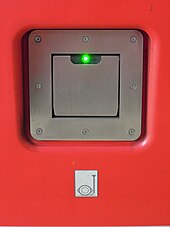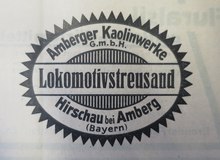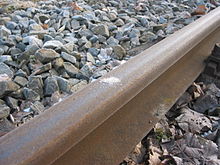Sand spreader

A sand spreader is a device used in rail vehicles in which, with the help of compressed air (approx. 8 bar) or by the action of gravity, sand is blown from a storage container (sandpit) through sand downpipes under the wheels or spread on the rails in front of the wheels, to increase the friction between wheel and rail. This is particularly useful in the case of a reduced coefficient of friction (e.g. due to wetness) and strong tractive or braking forces in order to improve the traction or braking effect and to prevent the wheels from slipping ( skidding or sliding ). The sand supply is measured in such a way that it usually only has to be replenished from inspection to inspection.
Dry brake sand is essential for the operation of the sand spreader. In steam locomotives , the sandpit was therefore regularly on the top of the long boiler in a separate sand dome , in which the sand was kept warm and dry by the boiler temperature. In modern vehicles, an electric heating coil is usually built into the sand storage container, which keeps the sand dry. In simple conditions (older tram vehicles) the sandpit was regularly in the heated passenger compartment.
Sand with high strength due to a high quartz content is used as brake sand. The sand should have a grain size of 0.8–1.6 mm according to TL 918 2243-5 or 0.71–1.6 mm according to BN 918 224 (see coarse sand) and be free of clay. The sand reserve must be checked as part of the final work on the vehicle and topped up if necessary.
History
The invention of the sand spreader is thanks to an unknown worker on the Camden and Amboy Railroad (C&A): In 1836, New Jersey was struck by a plague of grasshoppers . The crew was so dense that the safety of the train operation was no longer guaranteed. The C&A hired people to clear the tracks, which helped little or nothing. They also experimented with brushes and scratches, which were pre-tensioned for the locomotives, but slowed down the speeds so much that this also turned out to be useless. An employee experimented with fine sand that trickled onto the rails right in front of the locomotive, which solved the problem. It was also found to be useful for damp and slippery splints in particular, and has been in use ever since.
Operation of the sand spreader
The sand spreader is operated from the driver's cab of the rail vehicle. In the case of steam locomotives, they were actuated by means of compressed air, mechanical rods or a cable; the sand then fell through the force of gravity over the sand pipes in front of both wheels of the axle onto the rail. In modern traction vehicles, sanding takes place at the push of a button or automatically through the anti-slip or anti-skid protection. For this purpose, a solenoid valve is activated, which directs compressed air from the main air tank line (HBL) into a nozzle of the sanding device and thereby causes sand to be blown under the wheels via a hose or pipe.
On slippery rails and as soon as the wheels are expected to slide, the anti-skid devices respond or excessive slip occurs, the sanding device must be activated in accordance with DB guidelines. However, except in the case of imminent danger, sanding may not be used on bridges , switches , turntables , transfer platforms , track scales and in the area of filling stations for rail vehicles, as sanding could impair the function of movable and sensitive components. Excessive sanding should generally be avoided, as the crushed quartz sand can impair the electrical contact between wheel and rail and thus, in electric rail vehicles, the flow of current (return flow of traction current and track vacancy detection ).
hazards
Brake sand that is spread at low speed can cause an isolating effect between the wheel and the rail in individual locomotives. The resulting faulty track vacancy reports on electrical track circuits repeatedly led to collisions. The Federal Railway Authority instructed the railway companies to avoid sanding at speeds of 25 km / h (or less) with disc-braked locomotives.
In its report of August 20, 2013, the ARD magazine Report Mainz reported near-accidents in that the use of brake sand disrupted the electrical contact between wheel and rail and thus disabled train protection systems.
On August 1, 2013, there was a near collision between two S-Bahn trains in Mainz main station . On September 24, 2013, the Federal Railway Authority announced that the cause was too much brake sand on the tracks.
If too much sand is spread, it can rise (similar to sand rails ). This can lead to problems especially at those track points where the sand cannot slide off the side (e.g. at level crossings).
Last but not least, the sand increases the friction between rail and wheel flange, which counteracts wheel flange lubrication ; the reduced wheel flange lubrication also increases the risk of climbing.
Air pollution
In the vicinity of railway lines and thus also in the passenger area of the railway itself, wear on the wheel-rail-brake system typically produces a lot of iron (oxide) dust. Sanding causes sand containing quartz to be ground to fine dust between the rail and the wheel. Lung-accessible fine dust in particular with silicate and quartz content is particularly harmful. (Compare: Silicosis .)
In dry weather, massive dust swirls can currently be observed on tram routes there and those close by can experience it directly on the body (as a burning sensation in the eye, irritation in the respiratory tract, grinding between the teeth), where a lot of sand has been sanded, after which no rails are cleaned (sweeping with vacuuming) is where there is hardly any or only slow vehicle traffic on the rail route, when occasional emergency vehicles or replacement or night buses quickly drive over them.
With a generally slower tram speed, better visibility of the route and the trains, pedestrian-repellent design of the route in pedestrian zones and cooperative behavior of all road users, it is possible to reduce sand spreading processes and thus avoid a cause of serious dust swirling.
outlook
Due to the problems of sanding, other methods such as B. the free brushing of the rails discussed.
Sand spreader on road vehicles
Sand spreaders are also occasionally used on road vehicles. In contrast to the railroad, they mainly serve as a starting aid in difficult road conditions. Sand spreaders are mainly used in trolleybuses , which are technically related to the tram . Due to safety considerations with regard to the electrical insulation , these must not put on (metallic) snow chains , as otherwise a reverse current could occur via conductive elements in the road instead of via the contact line. But there are also known omnibuses and trucks that have been equipped with sand spreaders. The sand is usually scattered directly in front of the drive axle. The sand spreader has the advantage that assembly is not necessary before each use and it can also be used on roads without snow without damage; however, it is less effective than snow chains.
Web links
-
The EBA has tightened the general decree for the operation of the sand spreading device on rail vehicles from August 8, 2013 (23/2013)
- General decree 34aüt / 038-3418 # 003 as a PDF file; As of August 8, 2013
- General decree 34aüt / 038-3418 # 004 as a PDF file; Status: August 12, 2013
- Supplementary regulation for brake no. B 011 "Sanden" in force since March 1st, 2016 . Communication from the Federal Railway Authority dated March 31, 2016.
- Encyclopedia of Railways . 2nd Edition. Urban & Schwarzenberg, Berlin / Vienna 1923 ( zeno.org [accessed December 3, 2018]).
Individual evidence
- ↑ Michael Portillo: Great American Railroad Journeys . Simon & Schuster UK Ltd., London 2017, ISBN 978-1-4711-5151-4 , p. 43.
- ↑ DB AG group guideline 915.0107, section 1, paragraph 8
- ↑ DB AG Group Directive 492.0001, Section 3, Paragraph 14
- ↑ Safety is the top priority . In: Advance , January / February 2009 edition, ISSN 1438-0099 , pp. 8, 10
- ↑ Risky train brakes: Deutsche Bahn continues to rely on a controversial technology . Report Mainz, ARD, August 20, 2013, http://mediathek.daserste.de/
- ↑ Federal Railway Authority determined after a near collision of two S-Bahn trains at Mainz main station by Frank Schmidt-Wyk on Allgemeine-zeitung.de on August 2, 2013.
- ↑ Too much brake sand on the track on swr.de from September 24, 2013
- ↑ Verkehrsbetriebe Luzern: Annual report and accounts 1999 , p. 15
- ↑ The special way to travel at www.schwyzer-poschti.de
- ^ Paul F. Schneeberger: Verkehrsbetriebe der Stadt Luzern, 100 years of trams, buses and trolley buses. Minirex, Lucerne 1999, ISBN 3-907014-12-X
- ↑ Y 60 sand spreader on ger.autoline.no
- ↑ Motor car factory FBW: Chassis types L50, L70



